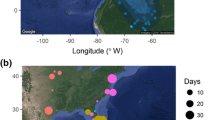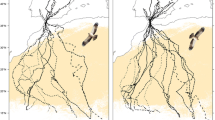Abstract
Long-distance migration is widespread among birds, connecting breeding and wintering areas through a set of stopover localities where individuals refuel and/or rest. The extent of the stopover is critical in determining the migratory strategy of a bird. Here, we examined the relationship between minimum length of stay of PVC-ringed birds in a major stopover site and the remaining flight distance to the overwintering area in the Eurasian spoonbill (Platalea l. leucorodia) during four consecutive autumn migrations. We also analysed the potential effect of timing (arrival date), as well as the role of experience in explaining stopover duration of spoonbills. Overall, birds wintering in Africa, and facing long-distance travel from the stopover site (ca. 3,000 km) stay for longer (2.7 ± 0.4 days) than Iberian winterers (1.5 ± 0.2 days) that perform a much shorter migration (ca. 800 km). These differences were consistent between years. Stopover duration was not significantly affected by the age of the bird. However, there was a significant reduction as migration advanced. Our results suggest that spoonbills develop different stopover strategies depending on the expected distance to the wintering grounds. Adults, especially long-distance migratory ones, could reduce the potential negative effects of density-dependence processes by avoiding stopover at the end of the migration period. These findings are of significant relevance for understanding differences in migratory behaviour within single populations, especially for declining waterbirds, as well as stress the relevance of preserving stopover localities for the conservation of intraspecific diversity in migratory species.



Similar content being viewed by others
References
Alerstam T, Hedenström A (1998) The development of bird migration theory. J Avian Biol 29:343–369
Alerstam T, Lindström A (1990) Optimal bird migration: the relative importance of time, energy and safety. In: Gwinner E (ed) Bird migration: physiology and ecophysiology. Springer, Berlin, pp 331–351
Alerstam T, Hedenström A, Åkesson S (2003) Long-distance migration: evolution and determinants. Oikos 103:247–260
Battley PF, Rogers DI, van Gils JA, Piersma T, Hassell CJ, Boyle A, Yang HY (2005) How do red knots Calidris canutus leave Northwest Australia in May and reach the breeding grounds in June? predictions of stopover times, fuelling rates and prey quality in the Yellow Sea. J Avian Biol 36:494–500
Bauchau V, Horn H, Overdijk O (1998) Survival of spoonbills on Wadden Sea islands. J Avian Biol 29:177–182
Berthold P (2001) Bird migration. University Press, Oxford
BirdLife (2004) Birds in Europe: population estimates, trends and conservation status. BirdLife Conservation Series 12. BirdLife International, Oxford
Boileau N, Caupenne M, Le Campion T (2001) Ecologie alimentaire de la spatule blanche Platalea leucorodia en migration postnuptiale dans le marais de Brouage (Charente-Maritime). Ann Soc Sci Nat Charente-Maritime 9:207–218
Cristol DA, Baker MB, Carbone C (1999) Differential migration revisited: latitudinal segregation by age and sex-class. In: Nolan V Jr, Ketterson ED, Thompson CF (eds) Current ornithol 15. Kluwer Academic/Plenum Publishers, New York, pp 33–38
De Voogd M (2004) Methods to sex juvenile Spoonbills and Sex-specific migration in Spoonbills. Master Thesis. Rijksuniversiteit Groningen
Dierschke V, Delingat J (2001) Stopover behaviour and departure decision of northern wheatears, Oenanthe oenanthe, facing different onward non-stop flight distances. Behav Ecol Sociobiol 50:535–545
Drent R, Both C, Green M, Madsen J, Piersma T (2003) Pay-offs and penalties of competing migratory schedules. Oikos 103:274–292
Gill RE, Piersma T, Hufford G, Servranckx R, Riegen A (2005) Crossing the ultimate ecological barrier: evidence for a 11000-km-long nonstop flight form Alaska to New Zealand and eastern Australia by Bar-tailed Godwits. Condor 107:1–20
Gudmunsson GA, Lindström A, Alerstam T (1991) Optimal fat loads and long-distance flights by migrating Knots Calidris canutus, Sanderlings C. alba and Turnstones Arenaria interpres. Ibis 133:140–152
Hake M, Kjellén N, Alerstam T (2003) Age-dependent migration strategy in honey buzzards Pernis apivorus tracked by satellite. Oikos 103:385–396
Hedenström A (2008) Adaptations to migration in birds: behavioural strategies, morphology and scaling effects. Philos Trans R Soc B-Biol Sci 363:287–299
Hedenström A, Alerstam T (1997) Optimum fuel loads in migratory birds: distinguishing between time and energy minimization. J Theor Biol 189:227–234
Lee DL, Black JM, Moore JE, Sedinger JS (2008) Age-specific stopover ecology of Black Brant at Humboldt Bay, California. Ecol 119:9–22
Lorenzo M, De le Court C (2007) Spoonbill winter population in the Iberian Peninsula and the Balearic islands. In: 31st Annual Meeting of the Waterbird Society. Universitat de Barcelona, Barcelona, p. 176
Meissner W (2007) Stopover strategy of adult and juvenile Red Knots Calidris c. canutus in the Puck Bay, southern Baltic. Ardea 95:97–104
Navedo JG (2006a) Identifying stopover wetlands for the conservation of an endangered waterbird species: the role of Santoña Marshes for the Spoonbill Platalea leucorodia during autumn migration. In: Triplet P, Overdijk O (eds) EUROSITE Spoonbill Working Group Newsletter, Vol. 4. pp. 48–51
Navedo JG (2006b) Efectos del marisqueo tradicional sobre la alimentación de las aves limícolas en áreas intermareales: aportaciones para la gestión de los estuarios cantábricos. Ph.D. Thesis, Universidad de Cantabria, p. 165
Navedo JG (2008) Different stopover timing in juvenile and adult spoonbills during southward migration. In: Triplet P, Overdijk O, Smart, M (eds) EUROSITE Spoonbill Working Group Newsletter, Vol. 6. pp. 2–5
Navedo JG, Masero JA (2007) Measuring potential negative effects of traditional harvesting practices on waterbirds: a case study with migrating curlews. Anim Cons 10:88–94
Newton I (2004) Population limitation in migrants. Ibis 146:197–226
Newton I (2006) Can conditions experienced during migration limit the population levels of birds? J Ornithol 147:146–166
Newton I (2008) The migration ecology of birds. Academic Press, London
Nolet BA, Gyimesi A, Klaassen RHG (2006) Prediction of bird-day carrying capacity on a staging site: a test of depletion models. J Anim Ecol 75:1285–1292
Pennycuick CJ, Battley PF (2003) Burning the engine: a time-marching computation of fat and protein consumption in a 5420-km non-stop flight by great knots, Calidris tenuirostris. Oikos 103:323–332
Piersma T (1987) Hop, skip or jump? constraints on migration of arctic waders by feeding, fattening and flight speed. Limosa 60:185–194 (In Dutch with English summary)
Piersma T, Zwarts L, Bruggemann JH (1990) Behavioural aspects of the departure of waders before long-distance flights: flocking, vocalizations, flight paths and diurnal timing. Ardea 78:157–184
Piersma T, Rodgers DI, González PM, Zwarts L, Niles LJ, do Nascimento ILS, Minton CDT, Baker AJ (2005) Fuel storage rates before northward flights in Red Knots worldwide: facing the severest constraint in tropical intertidal environments? In: Greenberg R, Marra PP (eds) Birds of two worlds: the ecology and evolution of migration. John Hopkins University Press, Baltimore, pp 262–373
Prop J, Black JM, Shimmings P (2003) Travel schedules to the high arctic: barnacle geese trade-off the timing of migration with accumulation of fat deposits. Oikos 103:403–414
Restani M (2000) Age-specific stopover behavior of migrant bald eagles. Wilson Bull 112:28–34
Salewski V, Schaub M (2007) Stopover duration of palearctic passerine migrants in the western Sahara—independent of fat stores? Ibis 149:223–236
Schaub M, Pradel R, Jenni L, Lebreton J-D (2001) Migrating birds stop over longer than usually thought: an improved capture-recapture analysis. Ecol 82:852–859
Scheiffarth G, Wahls S, Ketzenberg C, Exo KM (2002) Spring migration strategies of two populations of bar-tailed godwits, Limosa lapponica, in the Wadden Sea: time minimizers or energy minimizers? Oikos 96:346–354
Schekkerman H, Tulp I, Ens B (2003) Conservation of long-distance migratory wader populations: reproductive consequences of events occurring in distant staging sites. Wader Study Group Bull 100(Special issue):151–156
Schmidt-Wellenburg CA (2007) Costs of migration: short- and long-term consequences of avian endurance flight. Ph.D. Thesis, University of Groningen, p. 159
Skagen SK, Knopf FL (1994) Migrating shorebirds and habitat dynamics at a prairie wetland complex. Wilson Bull 106:91–105
Statsoft Inc. (2002) STATISTICA. http://www.statsoft.com
Triplet P, Overdijk O, Smart M, Nagy S, Schneider-Jacoby M, Karauz ES, Pigniczki Cs, Baha El Din S, Kralj J, Sandor A, Navedo JG (Compilers) (2008) International single species action plan for the conservation of the eurasian spoonbill Platalea leucorodia. AEWA Technical Series no 35. Bonn, Germany, p. 40 (plus annexes)
Ueta M, Higuchi H (2002) Difference in migration pattern between adult and immature birds using satellites. Auk 119:832–835
Viegas I, Martinho F, Neto J, Pardal M (2007) Population dynamics, distribution and secondary production of the brown shrimp Crangon crangon (L.) in a southern European estuary. Latitudinal variations. Sci Mar 71:451–460
Weber T, Alerstam T, Hedenström A (1998) Stopover decisions under wind influence. J Avian Biol 29:552–560
Acknowledgments
We thank Alejandro García-Herrera, Álvaro Bustamante, Máximo Sánchez-Cobo, Manuel A. Alcántara, Juan José Aja, Virginia Iturriaga and Ana Casero in addition to all the volunteers from the Spoonbill Migration Monitoring Program (SEO/BirdLife) for field assistance. Emma Dahl, Fernando Arce, Joaquín Bedia, Dra. Auxiliadora Villegas, Dr. Manuel Mota, Dr. Manuel Medina and an anonymous reviewer, helped to improve an earlier version of this manuscript. The Spanish Ornithological Society (SEO/BirdLife) and the Spanish National Parks Service provided us with logistic and financial support during the field work. JGN was currently supported by a postdoctoral fellowship of Plan Regional de Investigación (III PRI+D+I) of Junta de Extremadura.
Author information
Authors and Affiliations
Corresponding author
Additional information
Communicated by H. Mouritsen.
Rights and permissions
About this article
Cite this article
Navedo, J.G., Orizaola, G., Masero, J.A. et al. Long-distance travellers stopover for longer: a case study with spoonbills staying in North Iberia. J Ornithol 151, 915–921 (2010). https://doi.org/10.1007/s10336-010-0530-z
Received:
Revised:
Accepted:
Published:
Issue Date:
DOI: https://doi.org/10.1007/s10336-010-0530-z




